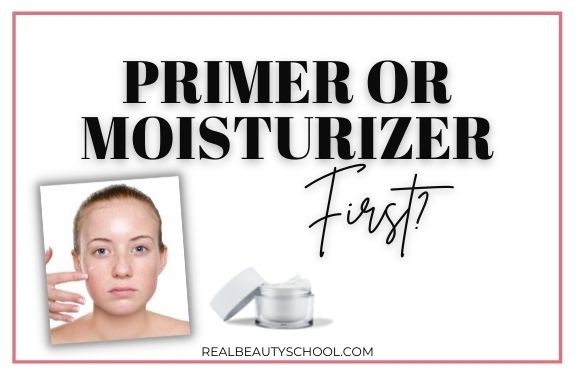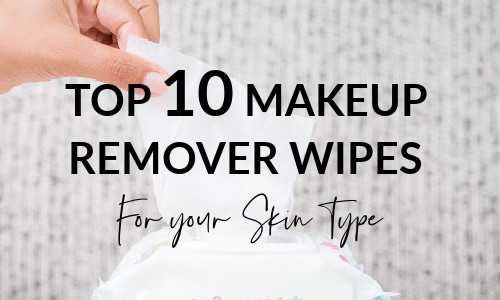Primer or moisturizer first? (Definitive Guide) Here’s when and how to use your moisturizer and primer the right way!
We all love the way makeup makes us feel. Makeup is a fun way to feel good about yourself, whether it’s a simple dab of lipstick or a full-on glam look. And we know that makeup looks best on skin that is well-prepped by a good skincare routine.
The sheer number of products on the shelves of beauty stores might make your head spin if you are not familiar with the world of makeup and skincare.
You are probably wondering where to begin and what to use. Which is skincare and which is makeup? Well, fear not, for you are hardly alone!
A common question makeup newbies have is regarding moisturizer and primer. Yes, they both look similar.
But can they be used together, or can you get by with just one? Which goes on first: moisturizer or primer?
We will address all your queries about moisturizers and primers right here. At the end of this article, you will learn the best ways to use your moisturizer and primer, and you will be one step closer to achieving your skincare and makeup goals!

This post may contain affiliate links. That means if you click and buy, I may receive a small commission (at zero cost to you). Please see my full disclosure policy for details.
Difference between moisturizer and primer
They may have similar color and consistency, but the first thing to know about moisturizers and primers is that they are not the same and work quite differently on the face.
A moisturizer is a skincare product. It serves as a barrier to keep the skin hydrated, soft, and supple. A good moisturizer should contain a combination of humectants, emollients, and occlusives to suit different skin types. Everybody can and should use a good moisturizer (and sunscreen) on a daily basis.
Humectants attract and lock in moisture, emollients soften, and occlusives form a barrier to prevent water loss from the skin. Your moisturizer and other skincare products will treat dry areas on your face and provide a beautiful base for your makeup.
A primer, on the other hand, is a makeup product. While some primers offer moisturizing effects, they are primarily a barrier base that sits atop your nourished skin and functions as a smooth canvas for foundation and other makeup products.
Like moisturizers, primers come in different styles too.
There are silicone-based primers for oily skin, water-based and moisturizing primers for dry skin, color-correcting primers to correct any underlying skin conditions, illuminating primers, mattifying primers, and so on. You can even find primers for eyelids, lashes, and lips!
A good rule of thumb, as explained by experts, is that moisturizer (and sunscreen) should be the last step of your skincare routine and primer, the first step of your makeup routine.
Which is better, moisturizer or primer?
It’s tough to pit primer and moisturizer against one another because they serve two different purposes. If you like to keep things minimal but like to get that radiant glow on your face, you need to focus on a good skincare routine.
You can skip using a primer if you are blessed with clear skin or do not need a long-lasting makeup look. Moisturizing should nevertheless be a mandatory part of your daily routine, irrespective of your skin type or makeup preference.
Can you use both moisturizer and primer?
Yes, you can use a moisturizer and a primer on your face one after the other. As we said before, one is skincare and the other is makeup, so both can go on your face and work together to produce a gorgeous finished look.
While a moisturizer can be used by anyone, regardless of skin type, a primer isn’t a must-have if you don’t need advanced makeup.
You might not need a primer if you have good skin with only minimal concerns or prefer a lighter makeup look. A tinted moisturizer or CC cream with some powder will work equally well.
Can a moisturizer replace primer?
The short answer is no. Moisturizers hydrate your skin, act as a barrier to retain moisture, eliminate dry patches, and protect your skin. But if you need to even out your skin and have your makeup look perfect and last long, it is better to include a primer.
For a lighter or everyday makeup application, you might be able to avoid using a primer as the hydration and grip provided by the moisturizer may suffice. But in some cases, moisturizers cannot replicate the properties of primer, as seen below:
Mattifying primer
A mattifying primer works by creating a matte base for makeup to adhere well to the skin. This formula works well for those with oily and shiny skin. Moisturizers are seldom able to provide a matte finish.
Silicone primer
Silicone primers are known for making skin feel silky smooth. They can fill in the pores, pits, and lines on your face and make it the perfect canvas for foundation to go on. It is better to avoid silicone-containing moisturizers as they do not generally have any skin-friendly benefits.
Color correcting primer
Different formulations of color correcting primers target different problem areas such as skin redness, dark circles, blemishes, dullness, discoloration, and so on. While moisturizers can help with healthy skin, they cannot correct skin imperfections as quickly as a primer can.
A happy medium is a moisturizing primer that, along with being a primer, also has hydrating elements. But that does not mean you can skip using your moisturizer and sunscreen. Moisturizing primers add extra hydration to your skin and make it smooth and soft. It also helps your makeup stay put for a longer time.
Primer vs moisturizer vs sunscreen.
Primers, moisturizers, and sunscreens are essential components of makeup and skincare. But unlike primers, moisturizers and sunscreen are imperative for maintaining skin health and protecting it from harsh environmental elements.
We discussed before how moisturizers are a vital part of your skincare arsenal. Equally necessary is a sun protection product with an appropriate level of SPF. Liberal application of sunscreen protects your skin from the sun’s harmful rays and helps to minimize any sun damage.
My favorite sunscreen to wear for flawless makeup is this one here. It is a non-greasy, dry-touch formula with SPF 70!
If you have a moisturizer, sunscreen, primer, and several other face products, you are probably confused about what order to apply them in. Here’s a basic step-by-step routine you can follow:
- Start by cleansing your face. I recommend a soap-free cleanser like this one.
- Depending on your skin type, exfoliate daily or weekly.
- Apply any serums or spot treatment solutions you might need.
- Layer on a good hydrating moisturizer like this one here.
- Top with sun protection (or you can use a moisturizer with SPF and skip additional sunscreen!)
- Allow it to dry for a couple of minutes before going in with a primer.
- Once the primer is set or tacky, you can apply foundation and the remainder of your makeup.
Related post: How to Apply your Makeup to avoid the Horrible Cakey dry foundation
Primer vs tinted moisturizer.
Tinted moisturizers are a great way to get the best of both worlds. It combines skincare and makeup into one and is a very convenient product for those on the go.
If you’re looking for a barely-there skin finish or want to add a healthy glow to your skin without multiple steps, tinted moisturizers are for you.
Tinted moisturizers, however, do not have long-staying power.
Nor do they camouflage more obvious skin concerns. This is when a primer might come in handy. If you prefer tinted moisturizer but want it to last longer, try a moisturizer-primer-tinted moisturizer routine and finish with a light powder.
CC creams and BB creams can also do the job of tinted moisturizers. If you don’t care for full, long-lasting coverage and only have minor skin concerns, you can use a tinted moisturizer instead of a primer and apply a foundation directly on top.
How long to wait between moisturizer and primer.
You know that moisturizers work effectively by locking moisture into your skin and keeping it nourished and plump.
Allowing a few seconds between layering multiple products will give your skin time to absorb all the goodness and let it stay fresh and protected throughout the day. A general recommendation is to wait 3-5 minutes between moisturizer and primer.
When you intend to follow your moisturizer and sun protection with primer and makeup, it is ideal to wait a couple of minutes between applications. Doing so lets each product dry down (or gets a bit tacky) and helps the next product stay in place.
Beauty experts advise waiting a minute between your moisturizer and sunscreen if using both separately. They recommended waiting at least five minutes before applying primer and another minute before foundation.
Of course, these are only general guidelines. The waiting times depend on the products used in tandem. Sometimes, moving too fast can result in products getting mixed up and not absorbed properly. This can make your face look blotchy and not give that fine, flawless finish.
Best primer and moisturizer in one

Moisturizing primers are a great base product since they combine the benefits of a moisturizer and a primer. These primers can be used by everyone, no matter their skin type. The extra boost of hydration and the skin-perfecting ingredients in the primer will ensure a dewy, glowing complexion that lasts for hours.
That said, these hydrating primers are not a substitute for moisturizers. They can, however, smooth and nourish your skin and make it look radiant even if you choose to go makeup-free.
Here are some of our picks for moisturizing primers:
1. E.L.F. Hydrating Face Primer

This fan-favorite primer is super affordable and moisturizes, fills pores, soothes, brightens skin, and ensures makeup is intact and lasts longer.
2. Bobbi Brown Vitamin Enriched Face Base Priming Moisturizer

This best-selling luxury primer works great for all skin types and sits very well on dry skin. The ingredients in this primer are very nourishing and make it a lovely moisturizing primer that provides amazing skincare benefits.
3. Milk Makeup Hydro Grip Hydrating Makeup Primer

This award-winning primer has many natural ingredients. The hydrating formula locks moisture in, blurs imperfections, and helps makeup last for around 12 hours.
4. NYX Professional Makeup Bare With Me Cannabis SPF 30 primer

These three-in-one primers hydrate, prime, and provide sun protection, all at the same time!
Conclusion on Moisturizer or primer first?
Moisturizers and primers are wonderful products that make your skin look beautiful and radiant. Unlike moisturizers, primers may be considered optional. However, if you struggle to keep your face looking fresh throughout the day or want makeup that doesn’t budge, you need a primer in your life!
The best way is to start with applying your moisturizer, wait 3-5 minutes to the moisturizer to dry and after that, apply your primer on top.
We talked about various kinds of primers here. You know what your skin needs, so choose products based on your preference. Experiment with different moisturizers and primers that complement your makeup and skin. It might take a while to figure out a routine, but we are sure you’ll be pleased with the results!
What’s Next? Check these Primer/Moisturizer Guides:
- The 10 Best Drugstore Primers to blur Fine lines and wrinkles!
- Hyaluronic Acid vs Retinol: How to use and which is the best for you!
- The Exact Skin-prep Routine to do before your Makeup!
- How to Make your Own Tinted Moisturizer at home! (Easy DIY)



